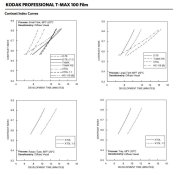If that is so, then I'm afraid I'm a complete dunce in this subject.
Not at all!!
You've got enough information in this thread already to make you an expert

Problems arise with the normal sequence of adjusting developing time to get the contrast you need for printing when your "printing" involves scanning, however.
In a purely analog workflow, one strives to find a development time that consistently gives negatives that print well on a medium-contrast-grade paper (e.g., grade 2 or 2.5). That gives lots of leeway on either side to deal with negatives from very contrasty or very flat scenes. Scanning throws a whole bunch of other variables into the mix in the form of automatic adjustments by the scanning software, etc. Still, the goal is the same: find a film speed and development time that works for you and gives you prints you like.
None of the manufacturers' recommendations are carved in stone; they are simply starting points. Every black-and-white photographer finds their own combination of personal film speed and development time.
It doesn't have to be complicated either (like the Zone System or BTZS). Just follow Kodak's simple advice:
If your negatives consistently need more shadow detail, expose more (i.e., use a lower effective film speed or E.I.). And vice-versa.
If your negatives are consistently too flat, develop longer, and vice-versa.
Keep playing around with the variables till you find what you need in terms of good shadow detail and negative contrast.
Best,
Doremus



 )
)

